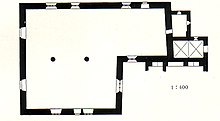Segenstal Monastery and St. Stephen's Church (Vlotho)
| Cistercian convent Segenstal | |
|---|---|

|
|
| location | Germany North Rhine-Westphalia |
| Coordinates: | 52 ° 10 '1.3 " N , 8 ° 51' 41.8" E |
| Patronage | originally St. George |
| founding year | 1252 |
| Year of dissolution / annulment |
1560 |
| Mother monastery | Tecklenburg-Leeden |
Today's St. Stephen's Church of the Lutheran community of Vlotho ( Herford ) has previously served for Cistercian nuns - and later Cistercian monastery Segenstal ( "Vallis benedictionis").
history
The Segenstal monastery was first founded in 1252 by Count Heinrich von Oldenburg from the Cistercian monastery Leeden . For this purpose, the count donated an estate in Rehme on the Weser. In 1258 the count donated the so-called Old Castle in Vlotho to the monastery. The residents of Vlotho must not have welcomed the new foundation very much, because in 1260 Pope Alexander IV , who had confirmed the monastery and taken it under his protection in 1259 , instructed the Archbishop of Cologne and the entire clergy to ban all laypeople and depose clergymen would disturb and diminish the monastery in possession of its goods.
Since the monastery grounds were in the floodplain of the Weser , it was relocated again in 1288 to Vlotho, which had become a town since the middle of the century. In 1289, the Archbishop of Mainz granted a 40-day indulgence to those who helped the nuns build the monastery. In 1306 the abbess Lucca von Vlotho asked the abbot of the Loccum monastery for advice, as she had to sell goods because of the great poverty of the monastery. Finally, the monastery church could only be consecrated after 36 years of construction. The consecration was carried out by Bishop Ludwig von Minden. Here the church was first dedicated to St. George consecrated.
1349 raged in the monastery plague and in the feud of the city Minden with Count Simon of Lippe , it was almost completely destroyed by fire. For the reconstruction, the nuns received a letter of indulgence from the bishops in Avignon . The economic situation of the monastery was then so bad that the nuns were repeatedly forced to sell and mortgage property of the monastery, including two volumes of the Old Testament in 1426. Some of the manuscripts were redeemed by the abbot of the Loccum monastery. As a result of the great poverty, monastic life was also damaged during this time. After a report from the Loccum abbot to the Pope, the monastery was closed and the nuns distributed between the Lilienthal monastery near Bremen and Rulle near Osnabrück.
In 1430 the Cistercians from Loccum took over the monastery, which was still dependent on the Abbot of Loccum. Although the monastery received new donations, the monks could not keep it either. In 1514 there was a report of a decline in religious discipline in the monastery. Due to the Reformation , the convent consisted of only four monks in 1533. After the death of the last monk in 1560, the monastery property was confiscated by the sovereign and the monastery was dissolved.
The former monastery church has served the Lutheran congregation of Vlotho since the Reformation as St. Stephen's Church as a place of worship. In 1659/60 the southern nave was added. The two naves of the same width with their own gables, longitudinal roofs and west entrances are built with a flush west facade and connected inside with two round pillars. The chapter house was used as a school house before it was demolished in 1654 and replaced by a new building. Today it is a youth home. Small parts of the cloister have been preserved southeast of St. Stephen's Church.
literature
- Karl Hengst (Ed.): Westphalian monastery book. Part 2: Münster - Zwillbrock. Aschendorff, Münster 1994, ISBN 3-402-06888-5 , pp. 67-70 ( sources and research on church and religious history 2, publications of the Historical Commission for Westphalia 44).
- Roland Pieper : Historical monasteries in Westphalia-Lippe. Ardey-Verlag, Münster 2003, ISBN 3-87023-244-7 ( Kulturlandschaft Westfalen 7).




